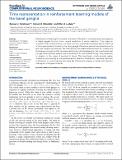Time representation in reinforcement learning models of the basal ganglia
Author(s)
Gershman, Samuel J.; Moustafa, Ahmed A.; Ludvig, Elliot A.
DownloadGershman-2014-Time representation.pdf (1.283Mb)
PUBLISHER_CC
Publisher with Creative Commons License
Creative Commons Attribution
Terms of use
Metadata
Show full item recordAbstract
Reinforcement learning (RL) models have been influential in understanding many aspects of basal ganglia function, from reward prediction to action selection. Time plays an important role in these models, but there is still no theoretical consensus about what kind of time representation is used by the basal ganglia. We review several theoretical accounts and their supporting evidence. We then discuss the relationship between RL models and the timing mechanisms that have been attributed to the basal ganglia. We hypothesize that a single computational system may underlie both RL and interval timing—the perception of duration in the range of seconds to hours. This hypothesis, which extends earlier models by incorporating a time-sensitive action selection mechanism, may have important implications for understanding disorders like Parkinson's disease in which both decision making and timing are impaired.
Date issued
2014-01Department
Massachusetts Institute of Technology. Department of Brain and Cognitive SciencesJournal
Frontiers in Computational Neuroscience
Publisher
Frontiers Research Foundation
Citation
Gershman, Samuel J., Ahmed A. Moustafa, and Elliot A. Ludvig. “Time Representation in Reinforcement Learning Models of the Basal Ganglia.” Frontiers in Computational Neuroscience 7 (2014).
Version: Final published version
ISSN
1662-5188